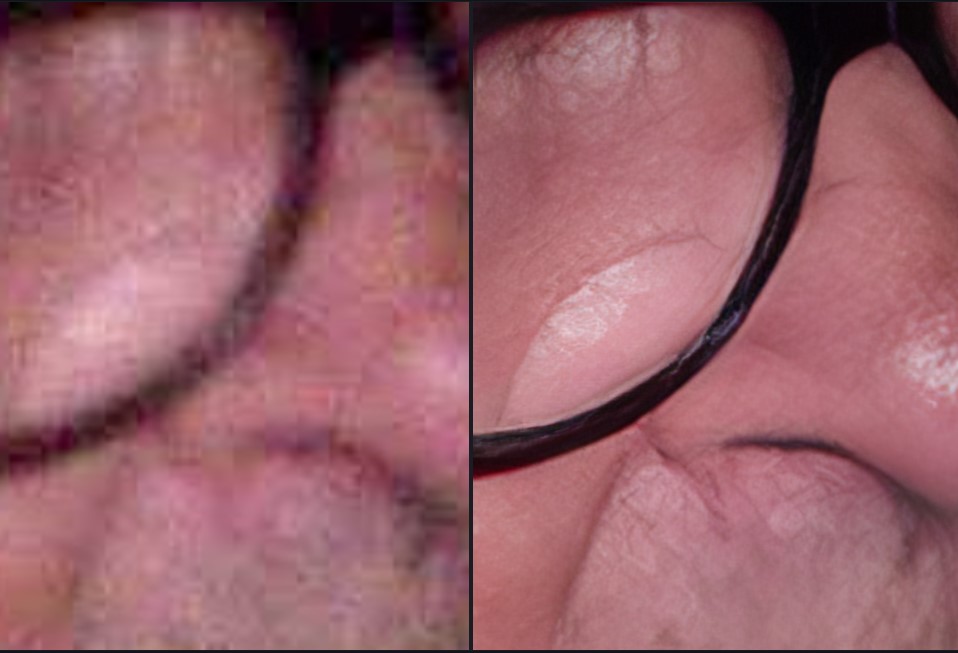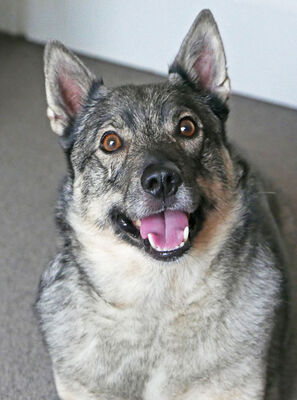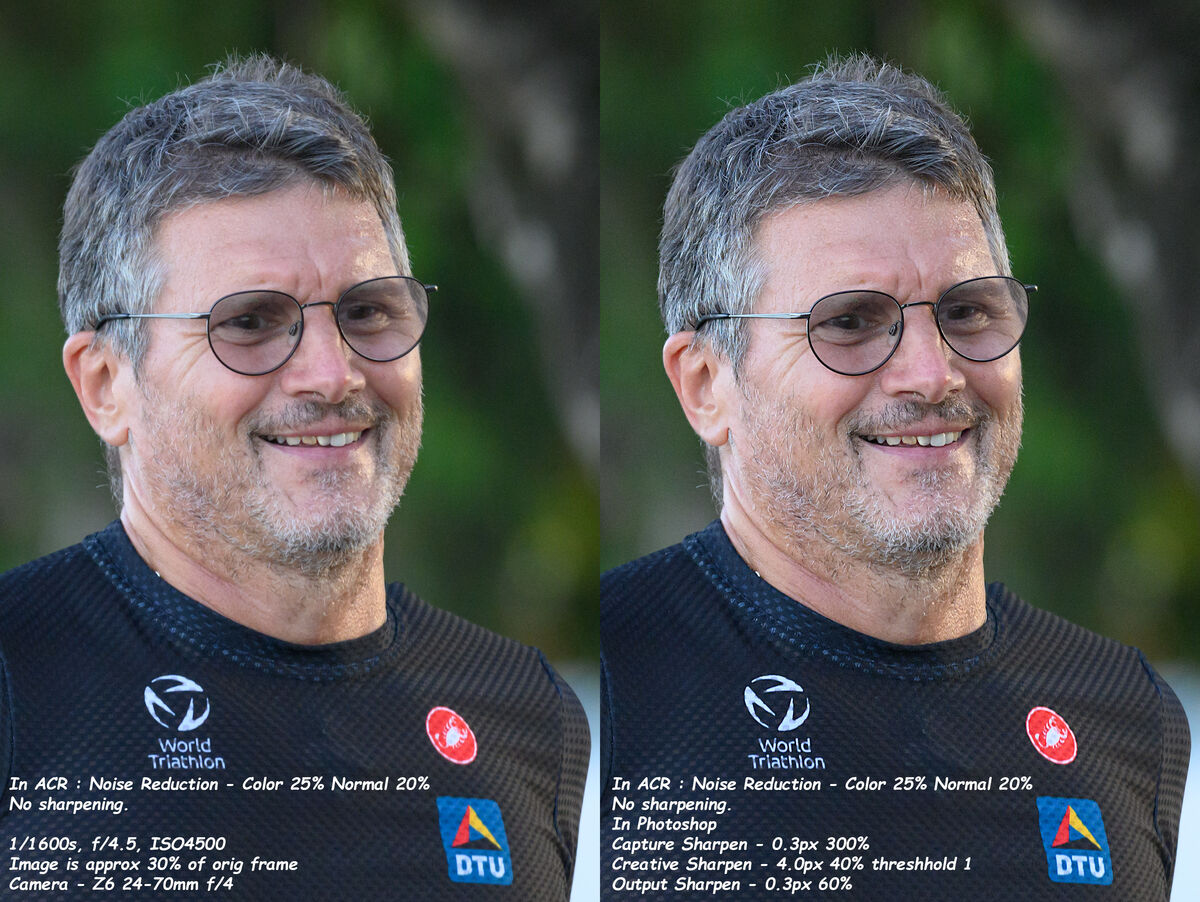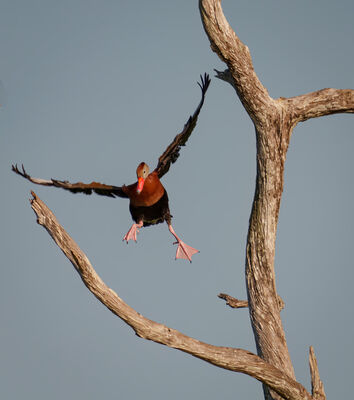Create really sharp photos
Jan 10, 2023 23:10:28 #
What process do you use to sharpen. I process my raws in adobe bridge adjusting exposure, highlights, shadows, etc all slider bars and saving detail (sharpness and noise) to be my last sdjustments in bridge. Then I open in Photoshop and do all my adjustments saving filter/sharpen/unsharp mask for last. Seems I am never quite sharp enough. I do hand held but always try for a shutter speed of 1/1250 or faster. I have read conflicting advice on using noise reduction. And even my camera lens recommends not using optical steady shot. I usually end up at the high end of my 200-600 lens so I understand that is problematic but I have seen others photos here at this range that are just crisp. Did a quick first pass at topaz that didn't seem to help much but maybe I need to learn how to use it more effectively. It would be interesting to hear what others do to maximize sharpness. Thanks
Jan 10, 2023 23:21:02 #
A fast shutterspeed won't help if you're forced to up the ISO over a lower value you could have used instead, at a minimally fast shutter as needed for the situation.
Sharpening and noise reduction are discussed in these two posts (applicable to most software, especially Adobe flavors):
Basics of noise processing
Basics of Lightroom Sharpening
Your sharpest images come directly from the camera, using techniques discussed in this post:
How to obtain sharp images in digital photography
Sharpening and noise reduction are discussed in these two posts (applicable to most software, especially Adobe flavors):
Basics of noise processing
Basics of Lightroom Sharpening
Your sharpest images come directly from the camera, using techniques discussed in this post:
How to obtain sharp images in digital photography
Jan 10, 2023 23:23:48 #
Additionally, presenting example images is much, much more effective as a basis for generating actionable feedback to address the issue, helping to ground the discussion on a common observation of the current situation.
Jan 11, 2023 01:00:10 #
Orphoto
Loc: Oregon
General agreement with paul. Techniques on camera do more to promote sharpness than anything else. Next up are quality optics. Post processing can mask some flaws but you are way ahead of the game if you start with crisp images.
Jan 11, 2023 01:28:47 #
I agree that camera technique is the most important aspect. Any post processing of an image that already has blur caused by camera shake is going to be a compromise.
What camera are you using, most now have a system that can be activated to compensate to a large degree for camera shake.
Without knowing the type of subject you are photographing at long range, either practice different techniques to hold the camera steady or alternatively try a monopod or tripod. Or if there is something nearby that you can hold the camera against to steady the lens is another alternative.
Failing that, I can only suggest using your feet to get closer to the subject and using a shorter focal length.
What camera are you using, most now have a system that can be activated to compensate to a large degree for camera shake.
Without knowing the type of subject you are photographing at long range, either practice different techniques to hold the camera steady or alternatively try a monopod or tripod. Or if there is something nearby that you can hold the camera against to steady the lens is another alternative.
Failing that, I can only suggest using your feet to get closer to the subject and using a shorter focal length.
Jan 11, 2023 03:43:44 #
Whilst technique is very important and already covered once you've captured the shot you are going to want to get the best out of it you can, if it's worth it to you. Many years ago when I started digital I was taught by a pro in the CiC forum that sharpening requires three separate stages and to this day I use the same process on images I want to be 'special'. I don't use the same process if I'm putting a few hundred event images on my site that are going to be downloaded and looked at on a phone, they get default ACR sharpening.
1. Capture sharpening.
This is done to counter the softening caused by the digitization process, AA filter and demosaicing process. It's done and only visible at 100% at typically 300% at 0.3pixels radius.
2. Creative (or Content) sharpening. (The one that makes images pop)
This is done to either the entire image or just the parts you want to stand out. In the example shown I have brushed it over just the face, hair, glasses and badges leaving edges alone. If the subject were a car we may just do the wheel hubs, or if a bird the eye and a few feathers. This is done at typically 40% at 4 pixels radius.
3. Output sharpening.
This is done when down-sampling to make the image smaller. When downsizing, the usual algorithm used in PS is Bicubic Sharper but I was advised that just using Bicubic and then 50 to 100% at 0.3 pixels radius is preferable.
Whilst I'm aware there are many sharpening methods used, I just took this advice and have never bothered to investigate further. I do have the full write up with pic examples in a word doc if anyone is interested.
1. Capture sharpening.
This is done to counter the softening caused by the digitization process, AA filter and demosaicing process. It's done and only visible at 100% at typically 300% at 0.3pixels radius.
2. Creative (or Content) sharpening. (The one that makes images pop)
This is done to either the entire image or just the parts you want to stand out. In the example shown I have brushed it over just the face, hair, glasses and badges leaving edges alone. If the subject were a car we may just do the wheel hubs, or if a bird the eye and a few feathers. This is done at typically 40% at 4 pixels radius.
3. Output sharpening.
This is done when down-sampling to make the image smaller. When downsizing, the usual algorithm used in PS is Bicubic Sharper but I was advised that just using Bicubic and then 50 to 100% at 0.3 pixels radius is preferable.
Whilst I'm aware there are many sharpening methods used, I just took this advice and have never bothered to investigate further. I do have the full write up with pic examples in a word doc if anyone is interested.
Jan 11, 2023 04:19:02 #
linda lagace wrote:
What process do you use to sharpen. I process my r... (show quote)
The following can affect sharpness.
Camera. Sensor itself, anti-alias filter, mirror slap, shutter shock, high ISO, camera shake.
Lens. Quality, bad copy, zooms in excess of 4x, using max zoom, auto or manual focus, dirty terminals.
Try f8 or f11. in rec. mode try increasing in-camera sharpness.
Try electronic shutter on mirrorless. (Flash may not work with electronic shutter). Try tripod.
PP. try high pass for sharpening or use clarity. Use only one type of sharpening. Try increasing contrast.
Jan 11, 2023 04:43:21 #
linda lagace wrote:
What process do you use to sharpen. I process my r... (show quote)
First of all, sharpness is only a part or element of a good photo. To always aim for sharpness is good but should not be too narrow of a focus to forget other photographic approaches.
Second, excellent the softwares maybe, but a great photo always starts with the proper capture.
If one aims to maximize sharpness; proper technique, sound choices and good equipment are essential foundations. From there, even an average photographic software will suffice.
For the photographer; follow through, no jerking the button and appropriate shutter speed are among the basics that should not be overlooked. As for the equipment, know the sweet spot of the lens being used and shoot from the correct distance. Cropping will always lower sharpness.
Any software sharpening is finding a solution to a problem. It is a compromise of enhancing contrast & noise against detail & final image size. Hence, always aim to get the best foundation image. That is where really sharp photos will come from.
On a final note,
The final saved filetype also affects sharpness. Use PNG/PNG-24 or similar bitmap type file that will save each pixel as is, instead of other filetype like JPEG which averages several pixels together.
Jan 11, 2023 06:16:10 #
Linda said, "Did a quick first pass at topaz that didn't seem to help much but maybe I need to learn how to use it more effectively." Was that the new Topaz AI? One can see that Topaz Denoise AI & Sharpen AI can make a sharp mountain out of a scattered mole hill. This photo is a snippet of eyeglasses and nose from a 2001 Kodak 3.1 mp [raw] taken as a JPEG file. The Topaz AI worked wonders even tho were not the latest editions.
NOSE EYEGLASS TOPAZ AI IMPROVEMENTS

Jan 11, 2023 06:34:38 #
linda lagace wrote:
What process do you use to sharpen. I process my r... (show quote)
Actually use a good quality lens.
I don't sharpen in post but adjust highlights and shadows.
If it was a difficult photo in low light a very slight noise reduction but very little.
But I don't sharpen as my camera and lenses seem to take care of that as can be seen in my postings.
Jan 11, 2023 06:57:01 #
billnikon
Loc: Pennsylvania/Ohio/Florida/Maui/Oregon/Vermont
linda lagace wrote:
What process do you use to sharpen. I process my r... (show quote)
There are sliders in photoshop RAW, there are also sliders in photoshop when you bring in a RAW to regular photoshop, in addition, there is Topaz DeNoise AI and Topaz Sharpen AI.
My Sony 200-600 is designed to be used in steady shot COMBINED with steady shot within the camera. I have never heard of a MODERN lens that recommends NOT using optical steady shot, never.
Noise reduction in DeNoise AI is excellent, I have never seen anyone not recommending that, I use it all the time without any issues ever.
Avoid any bird in flight under 1/2500 sec. if at all possible.
My 200-600 is very sharp throughout it's zoom range.
I believe we are talking about PILOT ERROR here. You need to reassess your shooting techniques.
Below is an extreme crop on a Red Shoulder Hawk hand held at a very slow shutter speed because of the shade it was taken in, DeNoise AI and Topaz Sharpen AI were used effectively in this example.
Sony a1, Sony 200-600mm lens, extreme crop.

Jan 11, 2023 09:02:45 #
Jan 11, 2023 09:12:06 #
linda lagace wrote:
What process do you use to sharpen. I process my r... (show quote)
Please post an original as captured example with EXIF data.
Jan 11, 2023 09:51:53 #
[quote=billnikon]There are sliders in photoshop RAW, there are also sliders in photoshop when you bring in a RAW to regular photoshop, in addition, there is Topaz DeNoise AI and Topaz Sharpen AI.
My Sony 200-600 is designed to be used in steady shot COMBINED with steady shot within the camera. I have never heard of a MODERN lens that recommends NOT using optical steady shot, never.
Noise reduction in DeNoise AI is excellent, I have never seen anyone not recommending that, I use it all the time without any issues ever.
Avoid any bird in flight under 1/2500 sec. if at all possible.
My 200-600 is very sharp throughout it's zoom range.
I believe we are talking about PILOT ERROR here. You need to reassess your shooting techniques.
Below is an extreme crop on a Red Shoulder Hawk hand held at a very slow shutter speed because of the shade it was taken in, DeNoise AI and Topaz Sharpen AI were used effectively in this example.
Sony a1, Sony 200-600mm lens, extreme crop.[/quot
My Sony 200-600 is designed to be used in steady shot COMBINED with steady shot within the camera. I have never heard of a MODERN lens that recommends NOT using optical steady shot, never.
Noise reduction in DeNoise AI is excellent, I have never seen anyone not recommending that, I use it all the time without any issues ever.
Avoid any bird in flight under 1/2500 sec. if at all possible.
My 200-600 is very sharp throughout it's zoom range.
I believe we are talking about PILOT ERROR here. You need to reassess your shooting techniques.
Below is an extreme crop on a Red Shoulder Hawk hand held at a very slow shutter speed because of the shade it was taken in, DeNoise AI and Topaz Sharpen AI were used effectively in this example.
Sony a1, Sony 200-600mm lens, extreme crop.[/quot
Jan 11, 2023 09:58:17 #
[quote=Delderby][quote=billnikon]There are sliders in photoshop RAW, there are also sliders in photoshop when you bring in a RAW to regular photoshop, in addition, there is Topaz DeNoise AI and Topaz Sharpen AI.
My Sony 200-600 is designed to be used in steady shot COMBINED with steady shot within the camera. I have never heard of a MODERN lens that recommends NOT using optical steady shot, never.
Noise reduction in DeNoise AI is excellent, I have never seen anyone not recommending that, I use it all the time without any issues ever.
Avoid any bird in flight under 1/2500 sec. if at all possible.
My 200-600 is very sharp throughout it's zoom range.
I believe we are talking about PILOT ERROR here. You need to reassess your shooting techniques.
Below is an extreme crop on a Red Shoulder Hawk hand held at a very slow shutter speed because of the shade it was taken in, DeNoise AI and Topaz Sharpen AI were used effectively in this example.
Sony a1, Sony 200-600mm lens, extreme crop.[/quot[/quote]
Hawk seems soft - not up to your usual standards.
My Sony 200-600 is designed to be used in steady shot COMBINED with steady shot within the camera. I have never heard of a MODERN lens that recommends NOT using optical steady shot, never.
Noise reduction in DeNoise AI is excellent, I have never seen anyone not recommending that, I use it all the time without any issues ever.
Avoid any bird in flight under 1/2500 sec. if at all possible.
My 200-600 is very sharp throughout it's zoom range.
I believe we are talking about PILOT ERROR here. You need to reassess your shooting techniques.
Below is an extreme crop on a Red Shoulder Hawk hand held at a very slow shutter speed because of the shade it was taken in, DeNoise AI and Topaz Sharpen AI were used effectively in this example.
Sony a1, Sony 200-600mm lens, extreme crop.[/quot[/quote]
Hawk seems soft - not up to your usual standards.

If you want to reply, then register here. Registration is free and your account is created instantly, so you can post right away.








